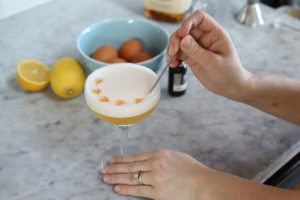
I’ve been wanting to write this post on egg whites for a long time. Egg whites are an ingredient in many classic cocktails including sours, flips, and fizzes. They make cocktails visually stunning and texturally interesting. But I’ve held off on writing about how to make the perfect egg white cocktail because getting that perfect layer of foam is honestly pretty difficult, and until recently I hadn’t been able to really do it to my own satisfaction. But I’ve finally managed to achieve egg white foam that’s thick and smooth enough to adorn with a fancy bit of bitters art. And I’ll tell you how I did it, and how you can too!
But before we talk about technique, let’s talk about egg whites more generally. What are they doing in your cocktail anyhow?
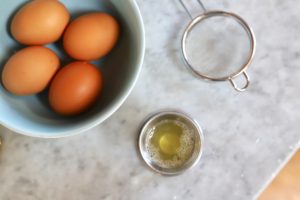
Some people can be a bit leery about drinking raw eggs, so it might surprise you to learn that egg whites have been in cocktails since at least the 1800’s, long before the advent of refrigeration. Using whole eggs goes back even further than that. The inclusion of egg is all about texture. Egg whites make a cocktail smooth and thick, with a layer of foam on top. It’s a totally different experience than drinking the same cocktail without them.
So, if you’re on board with tossing an egg into your drink, let’s talk about how to do it. To demonstrate, I made a classic whiskey sour: just whiskey, simple syrup, lemon juice, and egg white. The recipe is below.
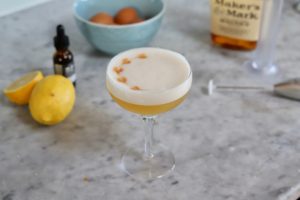
When working with egg whites, there are a few tips and tricks to remember. Since you will be consuming them raw, there is some risk of salmonella – it’s unlikely that the alcohol content of your cocktail will be quite high enough to sterilize anything. The odds of an egg being contaminated is fairly unlikely, but there are some things you can do to be extra safe. Make sure to use fresh eggs that have been stored in the refrigerator to prevent the growth of bacteria. Generally, eggs from local farms are going to be fresher than the ones you pick up at a grocery store. Do not use an egg if it has any cracks. If you’re extra leery about germs, you can buy pasteurized egg whites in a carton. These are also really useful if you’ll be making a lot of cocktails. However, I haven’t tried this so can’t vouch for their flavor or texture.
Once you have your eggs, you need to separate out the whites. If you’re a frequent baker, you probably already know how to do this like a pro. I’ve always liked the old fashioned way – just crack an egg down the middle on a flat surface and pull the two halves apart while holding the egg vertically, so that its contents collect in the bottom half of the shell. Then, over a bowl, transfer the yolk of the egg from one half of the shell to the other. The white will drip down into the bowl, leaving you with just the yolk in the shell. You can save it, discard it, or think of something else to use it for. (Creme brûlée, anyone?)
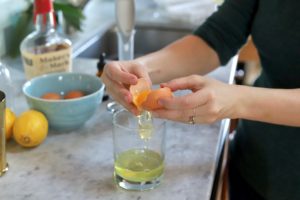
If you are particularly cautious or germ-averse and don’t want the whites to touch the outside of the eggs, another option is to place your Hawthorne strainer, spring side up, over a bowl or cup and crack the egg onto it. The whites should drip through the openings while the yolk stays on top.
Many older recipes call for the white of one egg, but today’s eggs are quite a bit larger than they used to be, so it’s better to use about a half ounce of egg white in each cocktail. Whites can be hard to measure out, so I recommend briefly whisking the white to break it apart a bit before pouring it into your jigger.
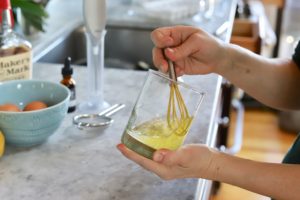
Once you’ve got all the ingredients for your cocktail in the tin, it’s time to shake. And this is where it gets a bit complicated if you really want to get it right. Shaking causes a proteins in the egg white called ovalbumins to unfold and bond with each other, the same way they do when you beat egg whites for baking. The best “explain like I’m five” explanation I’ve read is to imagine shaking up a box of slinkies – they’re going to get tangled up and stay that way. Acid helps with this process (with eggs, not slinkies, I imagine), which is why you add cream of tartar to your meringue; in cocktails, we’ve usually already got some citrus juice in there, so we’re good to go. Shaking also introduces air into the mixture, which is trapped by the chains of proteins.
Just like you need to really whip a meringue to get that perfect stiff texture, you’re going to need to shake your cocktail really, really well to get the foam you’re looking for. However, if you do all that shaking with ice, you’re going to over-dilute your drink. To prevent this, many bartenders do a dry shake of all the ingredients before adding the ice and shaking again. I’ve had trouble with this method because I find that the shaker doesn’t form a very good seal when it’s not cold, and leakage becomes an issue. For this reason, I prefer the reverse dry shake. To do a reverse dry shake, combine all your ingredients in the shaker with ice and shake like you would any other cocktail. When it is well-chilled, strain out the ice and shake again, this time for about 30 seconds. If, like me, you still don’t find that you’re getting that beautiful foam, you can add a blender ball or spring during that second shake, which acts like a whisk and additionally whips the whites. They sell tools specifically for this, but you can also just slip the spring off your Hawthorne shaker. I’ve even used one of these.
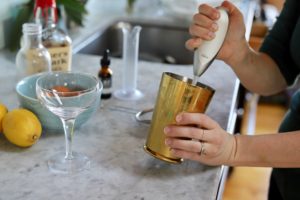
Doing a reverse dry shake with a spring has been my go-to method for a while, and I’ve made some lovely cocktails like the Pink Lady and Clover Club with this technique. However, I’ve never been quite happy with it. If you look closely, you’ll see that the foam on these isn’t quite smooth; there are some large bubbles. I’ve tried making bitters art on cocktails like these and it ends up just looking like a big blob.
Then, a few weeks ago, I was at the opening of a new bar Boston. One of their cocktails was made with egg whites, and I saw the bartenders mixing them with handheld milk frothers. The bar manager recommended this $10 Trudeau battery-operated frother, and I bought it. Sure enough, it worked like a charm. I shook my cocktail with ice, strained out the ice, and used the frother to mix it further. You want to bring the frother close to the surface to mix in some air and create foam. If anything, I occasionally frothed the cocktails too much, not an issue I’d ever had with shaking!
Is it cheating? Maybe. But it’s easy, and it works.
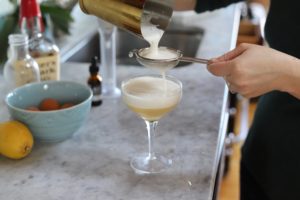
Whatever method you choose, I recommend fine-straining the cocktail through a mesh strainer to additionally separate out any larger bubbles. You should have a thick layer of smooth, snow-white foam on top of your drink. And I must say, it is so much fun to garnish. Edible flowers or dried citrus will sit effortlessly on top. Try dropping some bitters on the foam and running a cocktail pick through them to make some artful designs. You can even use a stencil and a spray bottle to create more elaborate art, something I’m looking forward to trying. A lot of bars are also using food-safe printers and rice paper or fondant to make cocktails that really look like works of art.
So that’s it! My guide to egg white cocktails. If you have any additional tips, please comment below!
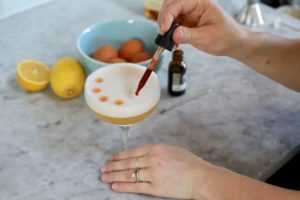
Whiskey Sour
2 oz. whiskey (I used bourbon)
3/4 oz. simple syrup
3/4 oz. lemon juice
1/2 oz. egg white
Combine all ingredients in a shaker and use one of the methods described above to mix and chill the cocktail. I shook with ice until the drink was cold, strained out the ice, and used a milk frother to achieve the foam pictured. Fine-strain into a coupe and garnish with several drops of aromatic bitters.






For the dry shake in a Boston shaker, position the cheater tin perfectly centered, as opposed to the cocked-to-the-side, normal way you do it with ice. This, and a good whack, keeps it from leaking.
Thank you – I’ll have to try this!